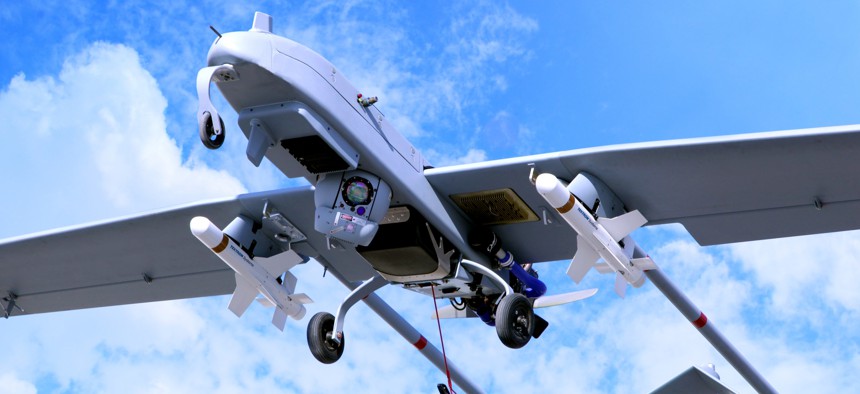
The Shadow 200 from Textron Systems equipped with precision-guided Fury bombs. Textron Systems
Is the Poor Man’s Predator the Future of Armed Drones?
If the U.S. loosens its rules on the export of armed drones, the biggest names won’t necessarily be the biggest winners.
ATLANTA — The future of armed drones isn’t necessarily bigger, more expensive and more sophisticated, even if that’s where companies like Northrop Grumman and Lockheed Martin seem to be headed. Take the Shadow 200, a UAV with a 12-foot wingspan. In a private test, the Shadow 200, and the slightly larger Shadow M2, both dropped precision guided bombs on a range near Arizona’s Yuma Proving Grounds last year, showing that even relatively simple drones can be made lethal at relatively low cost.
Made by Maryland-based Textron Systems and flown by the U.S. military under the designation RQ-7B, the unarmed Shadow 200 can fly about 77 miles and stay aloft for about 9 hours, and the company sells a satellite-linked version that can be flown beyond line of sight and from a remote location. It has a far smaller range and capacity than a $4 million Predator, but also costs significantly less, according to Textron, which wouldn’t provide an exact number. The savings are in “not just up-front cost, but in sustainment and other life-cycle costs,” Textron Systems said in an email.
The Pentagon has armed the Shadow for previous experiments going back to 2010, but Textron Systems funded the most recent tests. The company’s problem is that there’s no customer for an armed Shadow, at least not yet. “Our Shadow is flown at the brigade level in the U.S. Army. They’re saying the brigades have enough capability to hit and kill whatever they need to without arming those systems,” William Irby, Textron senior vice president and general manager told Defense One. “Right now, the Army’s position is ‘we’re not going to do that.’ They’ve just begun to field these systems with the combat aviation brigades with the Apache helicopter, which have all the kill capability that they need. The Shadow serves as the eyes and ears of that system.”
He added, “Right now, the U.S. government—specifically our largest customer, the United States Army—is not planning to weaponize the tactical-level system… However, there’s beginning to be another level of discussion that may indicate a willingness to do that in the future.”
Military buyers elsewhere in the world, eager to get their hands on a robot air force at the lowest possible cost, could gravitate to UAVs like the Shadow over bigger and costlier competitors. But export controls make it nearly impossible to get U.S.-made armed drones out of the country. “The point I’m trying to make is that our Shadow can be modified by mounting hardpoints onto the wings to carry weapons. But the international configurations that we would be approved to export do not have that capability,” said Irby.
Among other barriers, any country that wanted to buy an armed Shadow 200 would have to sign an end-use agreement with the U.S. government not to modify it, and to allow real-time monitoring of missions.
But rules change and controls can be loosened. In February, the State Department announced moves to allow the export of more armed drones to more countries, potentially including allies in the Middle East. The Department also said it would meet every case with a “strong presumption of denial.”
Some proliferation watchers in Washington have been applying steady pressure to get U.S. drones into the hands of allies, before up-and-coming rivals like China take over the market. Last year, China closed a deal with Saudi Arabia for their Wing Loong armed UAV, sometime called a Predator knockoff.
Today, 23 countries are developing armed drones or have done so already, according to a 2014 report from the RAND organization. Those numbers indicate a growing market for missile- or bomb-tipped UAVs, especially among players who can’t afford the fanciest bot on the lot. And just because it’s cheap doesn’t mean it won’t benefit from software innovations across the field. Future trends in autonomy aren’t going to be platform-specific. After all, machine intelligence is just lines of code.
At some point, someone will sell a poor man’s Predator. It may look something like this.
